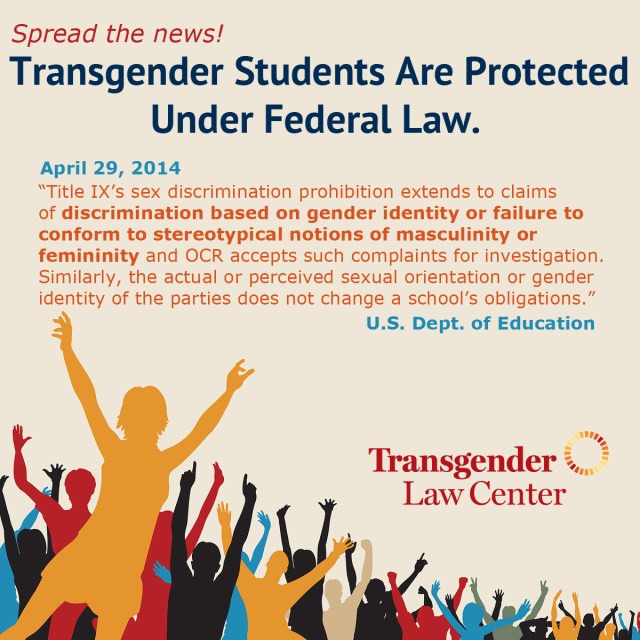On Tuesday, the Office of Civil Rights in the U.S. Department of Education issued a list of questions and answers on the implementation of its guidelines for Title IX, including explicit protections for transgender, gender nonconforming and queer students:
“Title IX’s sex discrimination prohibition extends to claims of discrimination based on gender identity or failure to conform to stereotypical notions of masculinity or femininity and OCR accepts such complaints for investigation. Similarly, the actual or perceived sexual orientation or gender identity of the parties does not change a school’s obligations.”
It continued:
“A school should investigate and resolve allegations of sexual violence regarding LGBT students using the same procedures and standards that it uses in all complaints involving sexual violence. The fact that incidents of sexual violence may be accompanied by anti-gay comments or be partly based on a student’s actual or perceived sexual orientation does not relieve a school of its obligation under Title IX to investigate and remedy those instances of sexual violence.”
Title IX is the federal civil rights law prohibiting federally funded education programs from discriminating on the basis of sex. This includes instances of sexual assault and harassment between people who attend and are employed by schools with federal funding — which is to say, almost all schools.

In 2011, the Office of Civil Rights released a “Dear Colleague Letter,” (DCL) which created a set of federal standards for schools responding to sexual violence in order to comply with Title IX. These clarifications responded to various questions that have arisen from the implementation of the DCL guidelines over the past three years. Along with providing inclusion for gender identity and sexual orientation, they noted that undocumented students and students with disabilities are protected from gender-based discrimination under Title IX, and discussed the extent to which campus resources can maintain confidentiality.
Explicitly including trans, gender nonconforming and queer populations in Title IX protections is incredibly important for students who are seeking fair treatment and access within their educational institutions. The Transgender Law Center noted the positive impact of a similar law implemented on the state level in California, which includes mandates that students be able to access gender-segregated spaces like bathrooms and locker rooms that reflect their gender identity, and to be referred to by their correct pronouns and names. Julian Williams, Title IX Officer at Vassar College, said, “[the new clarifications] really raise the bar for schools to say, ‘look, this is what you have to do and now it’s up to you to figure out what you need to do to respond and to really make your campuses safe and welcoming for [transgender] students.'”
The clarifications released from the OCR set a standard and hold colleges accountable for responding to complaints brought by trans, gender nonconforming and queer students, and for providing them with the accommodations they are entitled to to feel as safe as possible at school. These accommodations include measures like helping students switch living situations or classes without academic or financial penalty when they file complaints. This can offer essential relief to students living and studying in the close quarters of a college community, and can be especially useful for trans, gender nonconforming and queer students seeking safe living situations, whether or not they have experienced assault.
However, in order for these guidelines to be implemented for queer, trans and gender nonconforming students effectively, schools need to invest in trainings and institutional adjustments so schools can be responsive to the unique needs of gender nonconforming, queer and trans students. Unfortunately, the updates to the DCL contain almost no information about how support for transgender, gender nonconforming and queer students can be implemented into school policies or introduced to administrators who may not be familiar with trans issues. It encourages training, but it is unspecific about what that training would entail. And as Williams further noted, “a lot of people making these decisions in these institutions aren’t really well versed in how to do these things, so that’s where the challenges are going to arise.”
While the inclusion of gender nonconforming, trans and queer populations explicitly in the DCL are useful, gender nonconforming, trans and queer identities still clearly not the priority in the federal government’s response to sexual violence in schools. While Williams expressed the importance of listening to the needs of trans, gender nonconforming and queer students and adapting school responses to individual situations, the recommendations of the Office of Civil Rights more closely advise schools to treat trans students and queer students as they would anyone else: “A school should investigate and resolve allegations of sexual violence regarding LGBT students using the same procedures and standards that it uses in all complaints involving sexual violence.” It does not discuss the possible need to adapt responses to best fit the needs of individual students — something that would ultimately not only benefit transgender, gender nonconforming and queer students, but any student needing a response specific to their own situation.

Title IX provides guidelines for best practices because we students are demanding a response to the rampant sexual violence on college campuses, and while our calls are heard, it is vital that we remain vigilant about the impact of policies responding to sexual violence, especially since our schools depend on funding from the federal and state governments that make the policies. We need to hold our schools accountable to implement these new policies in ways that reflect our needs and our safety.
We have hit a point where support for trans, gender nonconforming and queer students is becoming a national issue, with inclusion polices from California to New York City public schools, but doing so in name only is not enough. Transgender, gender nonconforming and queer students have unique needs that educators and administrators are not always familiar with. More dramatic systemic overhaul needs to happen for inclusion and justice to be a reality.

